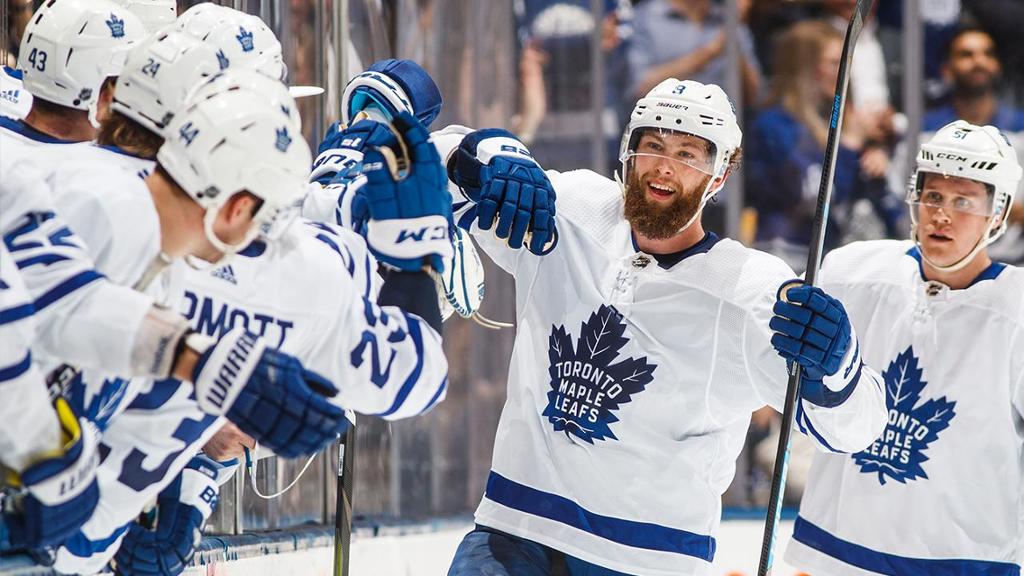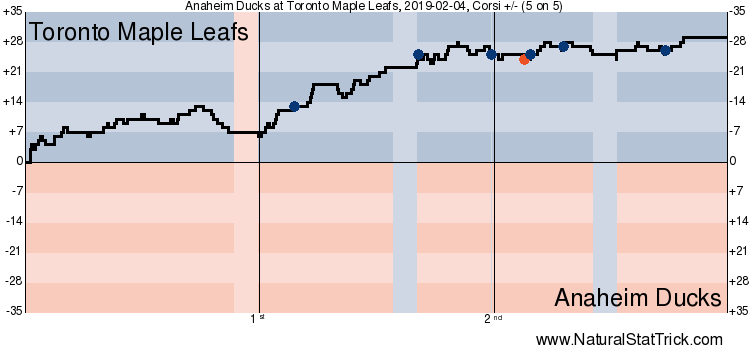The Toronto Maple Leafs put together their first set of back-to-back wins of 2019 with an emphatic win over the floundering Anaheim Ducks on Monday night.
First Period
The Leafs have been guilty of a lack of urgency early in games against struggling opponents of late, but bucked that trend in a big way tonight, coming close to taking an early lead on multiple occasions. The Leafs had their skating legs early and were pressing a fragile Ducks team into all kinds of turnovers, forcing John Gibson to stand on his head to keep the Ducks in the game.
The 4th line forces a turnover and ends up getting a quality scoring chance. #LeafsForever pic.twitter.com/5F3aohiHqC
— Maple Leafs Hotstove (@LeafsNews) February 5, 2019
Not to kick a team when it is down, but it was astounding to watch how disorganized this Ducks team was coming out of its own end as well as in just about every other facet of the game.
The Jake Muzzin and Morgan Rielly pairing were demonstrating their budding chemistry with smooth play at both ends of the ice, creating quality chances in the offensive zone and turning defense into offense at the other end.
Here's a prime example of what makes the Muzzin-Rielly pairing effective. Instead of scrambling to get the puck out of the zone, both settle the puck down and retake position. Results in Rielly springing Kapanen free with a stretch pass. #LeafsForever pic.twitter.com/agXpSPtmn8
— Maple Leafs Hotstove (@LeafsNews) February 5, 2019
As the period progressed, the Leafs kept up the momentum and continued to pile on the high-quality scoring chances. Perhaps their best chance of the period came off a turnover in the offensive end.
A hard-working shift for the Kadri line once again results in some quality scoring chances. At the tail-end of it, Hyman pounces on a bad pass and nearly cashes in. #LeafsForever pic.twitter.com/KBhZmQl5NH
— Maple Leafs Hotstove (@LeafsNews) February 5, 2019
The Kadri line with Brown and Nylander, in particular, was buzzing on the forecheck, forcing turnovers and generating o-zone cycle time in the offensive zone throughout the first period and much of the game, but the Leafs had four lines going pretty well and just couldn’t find the offensive breakthrough.
When the horn sounded, both teams headed to the locker room scoreless, with Ducks 29th-ranked power play failing to generate much of note on one opportunity. For the Ducks, they were relieved just to survive after allowing six goals in the first period of their previous game against the Winnipeg Jets. The Leafs were clearly the better team through 20 minutes, though, and it seemed inevitable that they’d break through in the middle 20.
Second Period
Roughly three minutes into the frame, Toronto finally opened the scoring.
Great sequence from the Leafs in the defensive zone and it turns into offensive. What a rocket from John Tavares who snaps an 8-game goal drought. 1-0 Leafs. #LeafsForever pic.twitter.com/8XFOJkH1Qi
— Maple Leafs Hotstove (@LeafsNews) February 5, 2019
This goal came with a mishmash unit from the Leafs as they were in the midst of a partial change; Ray Ferraro noted from between the benches that the Leafs often send their centerman over the boards first, which makes a lot of sense. The short-side snipe from John Tavares was impressive, but Tavares also initiates that play with a nifty between-the-legs bump pass off the defensive-zone wall to get it all started, while Andreas Johnsson made a heads-up play to catch the Ducks out in transition.
After that goal, the Ducks briefly snatched momentum away and generated a few chances of their own, but Frederik Andersen — who came up with a number of timely saves in this game, even if the shot count was light — was able to hold down the fort, including this tricky save off a redirected shot from Ryan Getzlaf.
Frederik Andersen makes a key save after Ryan Getzlaf's shot gets deflected off Morgan Rielly's stick. #LeafsForever pic.twitter.com/NDm9M6LPoz
— Maple Leafs Hotstove (@LeafsNews) February 5, 2019
The Ducks eventually took a penalty to put the Leafs back on the power play, where the Leafs came close to extending their lead with some quality looks to no avail during the two-minutes. There was better movement and rotation from the top power-play unit, but Gibson stood tall on a good look for Nazem Kadri in the slot.
It matter not as the Leafs ended up scoring an unofficial power-play goal nonetheless just seconds after the PP expired.
The Leafs can't convert on the man advantage but it doesn't matter. Muzzin's blast from the point creates chaos in front and results in a Johnsson goal. 2-0 Leafs. #LeafsForever pic.twitter.com/8BV7fQHwhs
— Maple Leafs Hotstove (@LeafsNews) February 5, 2019
The second power-play unit is clearly benefitting from the added dynamic of Muzzin’s ability to deliver a hard, accurate shot through traffic. Johnsson buried the loose puck in front to snap a seven-game goalless drought.
Following the insurance tally, the Leafs continued to apply the pressure from the driver’s seat. As the clock winded down on the period, Muzzin once again made his presence felt.
Jake Muzzin demolishes Corey Perry with a big hit near the Ducks bench. #LeafsForever pic.twitter.com/24Gv0zXeq8
— Maple Leafs Hotstove (@LeafsNews) February 5, 2019
This is now the second consecutive game that Muzzin has laid a big hit in a game and much like the one on Jake Guentzel on Saturday, it really got the crowd into the game. It also got under Ducks’ skin as Muzzin was able to draw a penalty off of an undisciplined cross check from Nick Ritchie on the following shift. Those are the kind of momentum-shifting, crowd-inciting physical plays the Leafs were sorely lacking; momentum shifts can’t always come from scoring plays. It also comes as no surprise that engaging physically within rules helps to draw opponents into crossing the line and retaliating.
On the ensuing power-play opportunity, Muzzin, who already got his first point as a Leaf in the second goal of the night, ripped home his first in the Blue and White to complete one highly impressive sequence of hockey from the new Leaf.
The Leafs got a late power play and they pounce almost immediately. What a blast from Muzzin for his first goal as a Leaf. 3-0 Leafs. #LeafsForever pic.twitter.com/HecTyTlbPj
— Maple Leafs Hotstove (@LeafsNews) February 5, 2019
Muzzin is really going to give the Leafs power play a shot in the arm and the opponents something to respect other than the half-wall looks and seam plays.
After tempers boiled over when the horn sounded, the Leafs headed back to the locker room with a 3-0 advantage over the Ducks. They were in complete control of the game by that point and just needed a clean defensive showing in the final frame.
Third Period
Anaheim was the better team in the opening minutes of the third period, and briefly made things semi-interesting when the Leafs backed off their own blue line too easily — Gardiner and Zaitsev need to be stiffer at the line — and Rickard Rakell took full advantage with a far-side snipe past Andersen.
Rakell with a perfect shot to put the Ducks on the board. 3-1. pic.twitter.com/JmBH2ZwD3Q
— Flintor (@TheFlintor) February 5, 2019
The response from the Leafs was perfect and it came through someone in dire need of something to break his way.
It didn't take long for the Leafs to restore their 3-goal lead. Great pass from Muzzin to set up this rush. Even better pass from Nylander to assist on Brown's goal. 4-1 Leafs. #LeafsForever pic.twitter.com/Sx8YqBAIC0
— Maple Leafs Hotstove (@LeafsNews) February 5, 2019
This was a vintage pass from William Nylander, fairly similar to the assist he dished out to Patrick Marleau against the Carolina Hurricanes a few months back; he’s quite adept at holding onto the puck that extra beat, keeping the goaltender in place, and sliding it in behind the last defender for the backdoor tap-in.
That assist immediately went to Nylander’s legs as he finally broke through with a goal of his own just minutes later.
Everything is going well for the Leafs right now. Nylander fires an absolute bullet of a shot for just his second of the season. 5-1 Leafs. #LeafsForever pic.twitter.com/mtXtr5I7oV
— Maple Leafs Hotstove (@LeafsNews) February 5, 2019
This is is more like it from Nylander, who it’s been easy to forget has one of the best shots on the Leafs roster when he is feeling it and (most importantly) actually hitting the 6×4. Nylander’s second of the season ended Gibson’s night; remarkably, the Ducks goaltender been pulled in three consecutive starts for the Ducks.
With the game well decided by this point, emotions ran high as both teams mixed it up in a scrum during a stoppage of play on a Leafs power play, and it was good to see the Leafs not back down from the physical challenge. It was noticeable how much the Leafs seemed to feed off of the presence of someone who can hold his own and throw his weight around in Muzzin.
As the clock winded down, the Leafs continued to pile on the offensive zone pressure and their efforts were rewarded again thanks to Johnsson.
Andreas Johnsson scores again to extend the Leafs lead further. His 4th point of the night, makes you wonder why he isn't in the top-9 right now. 6-1 Leafs. #LeafsForever pic.twitter.com/NNnIYGzyUZ
— Maple Leafs Hotstove (@LeafsNews) February 5, 2019
Started on the fourth line, ended with a four-point night.
Clip of the Night
Morgan Rielly to the referee: "You f****** hero." #LeafsForever pic.twitter.com/sfdTo5yle5
— Maple Leafs Hotstove (@LeafsNews) February 5, 2019
Notable Stats
Jake Muzzin has registered his first point as a Maple Leaf with a second period assist. #LeafsForever
— Leafs PR (@LeafsPR) February 5, 2019
Jake Muzzin equaled his single-game career-high with three points tonight – the sixth time he has accomplished the feat in his career. #LeafsForever
— Leafs PR (@LeafsPR) February 5, 2019
Frederik Andersen has recorded his 94th win as a Maple Leaf tonight, passing Ed Belfour for sole possession of ninth place on the franchise’s wins by a goaltender list. #LeafsForever
— Leafs PR (@LeafsPR) February 5, 2019
Leafs’ fourth line winger Andreas Johnsson has one more point than the Oilers’ highest scoring winger and ten more points than their second highest scoring winger
— CorsiHL (@CorsiHL) February 5, 2019
Game Flow: 5v5 Shot Attempts
Post Game Notes
- Jake Muzzin showcased exactly why the Leafs went out and traded for him last week, checking all kinds of boxes for this team — effective in possession, in the defensive zone, on special teams, and in the physical department. The team and crowd really fed off of his performance. A three-point performance ties a career-high, and that willingness to shoot and deliver an accurate, hard slap shot from the top of the power play setup is a sorely-needed dynamic changer that should help keep the opposition PKs more honest. There was lots of pressure coming home to the Toronto market to join a team in need of a pick-me-up — one that was struggling at home also — and he’s been an impact player and instant crowd pleaser in the last two games. Would Jim Hiller consider deploying him on the top PP unit here and there to give the PKs something new to think about?
- What a night for Andreas Johnsson offensively. A four-point night tied the career-best established against the Philadelphia Flyers back in November, and he was a 66.7 Corsi-For% and 69.2 SF% at 5v5. It looks like he’s sick of starting on the fourth line; he was really hungry and determined throughout the game, and when he’s playing with that kind of gumption, the puck seems to follow him around the ice. Everything seemed to fall for him, similar to that Flyers game.
- Needless to say, this was a game William Nylander desperately needed. Finishing the game with two points, including his first goal since January 3rd (just #2 on the year), should give the 22-year-old some confidence down the stretch to start producing like the player fans have come to expect. At even strength, he led all Leafs players in Corsi-for% (72.73), SF% (73.08), SCF% (80.77), and was 5th HDCF% (85.71). As much as Johnsson warrants a return to the top nine, that line with Brown and Kadri is going to be tough to break up with how well it is forechecking and cycling. With a pretty favourable schedule awaiting the Leafs, perhaps February is finally Nylander’s breakout month.
- The win gave Frederik Andersen his 94th win as a Toronto Maple Leaf, which passed Ed Belfour for 9th on the all-time franchise wins leaders. That’s quite impressive given this is only his third season with the club, and it was good to see the Leafs step up for Freddy against his former team. Next up on the list is Lorne Chabot with 102, who Andersen should be able to pass by season’s end.
- While the Ducks did a ton of throwing the puck away and dumping it out/in to nobody, failing to establish much of a sustained forecheck throughout the game, we saw some really good execution from the Leafs coming out of their own zone with shorter tape-to-tape passes to generate speed from behind the puck. The Muzzin-Rielly pairing, and limiting Ron Hainsey’s minutes to a more manageable workload on a more sheltered pairing with Travis Dermott, is delivering the expected results so far, but it’s also about the forwards’ willingness to stay close and provide those manageable outlets. As a result, the Leafs have dominated the possession game for the past 120 minutes of hockey against two very different opponents — a high-pace Pittsburgh team and a heavier, more methodical (albeit badly-struggling) Ducks team.





































